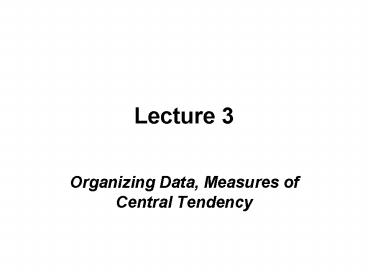Organizing Data, Measures of Central Tendency - PowerPoint PPT Presentation
1 / 22
Title:
Organizing Data, Measures of Central Tendency
Description:
Levin, J. & Fox, J. A. (2006) ... Walsh, A. & Ollenburger, J. C. (2001). Essential Statistics for the Social and Behavioral Sciences: A Conceptual Approach. ... – PowerPoint PPT presentation
Number of Views:414
Avg rating:3.0/5.0
Title: Organizing Data, Measures of Central Tendency
1
Lecture 3
- Organizing Data, Measures of Central Tendency
2
Bibliography for This Lecture
- Greer, B. Mulhern, G. (2002). Making Sense of
data and Statistics in Psychology. Houndmills
Palgrave. - Levin, J. Fox, J. A. (2006). Elementary
Statistics in Social Research The Essentials
(2nd Edition). Pearson Education, Inc. - Walsh, A. Ollenburger, J. C. (2001). Essential
Statistics for the Social and Behavioral
Sciences A Conceptual Approach. Prentice Hall. - Weiss, N. A. (2008). Elementary Statistics (7th
Edition). Pearson Education, Inc.
3
Organizing Data
- A teacher asked her students how many novels they
had read in the previous six months. The results
were - 0, 1, 5, 4, 2, 1, 3, 2, 2, 7, 2, 5, 0, 1, 0,
- 1, 1, 2, 6, 0, 2, 3, 1, 2, 7, 1, 4, 2, 3, 1,
- 7, 0, 0, 2, 1, 1, 0, 6, 1, 7.
- How can we conclude here what can we say about
novel reading habits of these students?
4
Frequency Distribution-Definitions
- Frequency Number of times a value of the
variable occurs (f). - Cumulative frequency The value of each new
category is added to the one preceding it. Helps
to identify the total frequencies below or above
a certain category. - Proportion/relative frequency Compares a part
of the distribution with the whole. - Percentage Proportion standardized to 100.
- Ratio Comparison of two quantities relative to
one another.
5
Frequency Distribution Ex
- Table 1 Number of novels read in the past 6
months
6
Frequency Distribution ExTable 2 Preference
for news medium
7
Frequency Distribution ExTable 3
Satisfaction with life
8
Grouped Frequencies
- Terms Used in Grouping
- Classes/intervals Categories for grouping data.
- Lower cutpoint/limit The smallest value that
could go in a class. - Upper cutpoint/limit The highest value that
could go in a class. - Midpoint The middle of a class, found by
averaging its cutpoints. - Width The difference between the cutpoints of a
class.
9
Table 5 Frequency distribution of age
10
Table 6 Grouped frequency distribution of age
11
Table 6 Grouped frequency distribution of age
(real limits indicated)
12
Summarizing Data
How can we summarize what is going on in our data
set? Basic descriptive statistics Such as
percentages, proportions, and rates. Measures
of central tendency Mean, median and mode. Give
us an idea about the typical values. Measures
of dispersion range, variance, quartiles,
standard deviation. Show us how the data is
dispersed.
13
Percentages and Proportions
- Report relative size.
- Compare the number of cases in a specific
category to the number of cases in all
categories. - Compare a part (specific category) to a whole
(all categories). - The part is the numerator (f ).
- The whole is the denominator (N).
14
Percentages and Proportions-Ex.
- In a group of 97 male and 132 female social
science majors, what percentage of them is male? - The whole is the number of people in the group.
- The part is the number of males.
15
- What of social science majors is male?
- of (whole) all social science majors
- 97 132 229
- is (part) male social science majors
- 97
- (97/229) 100 (.4236) 100 42.36
- 42.36 of social science majors are male
16
Ratios
- Compare the relative sizes of categories.
- Compare parts to parts.
- Ratio f1 / f2
- f1 - number of cases in first category
- f2 number of cases in second category
17
Ratios-Ex.
- In a class of 23 females and 19 males, the ratio
of males to females is - 19/23 0.83
- For every female, there are 0.83 males.
- In the same class, the ratio of females to males
is - 23/19 1.21
- For every male, there are 1.21 females.
18
Rate
- Expresses the number of actual occurrences of an
event (births, deaths, homicides) vs. the number
of possible occurrences per some unit of time.
19
Rates
- Birth rate is the number of births divided by the
population size times 1000 per year. - If a town of 2300 had 17 births last year, the
birth rate is - (17/2300) 1000 (.00739) 1000 7.39
- The town had 7.39 births for every 1000 residents.
20
Expressing change over time
- Measures the relative increase or decrease in a
variable over time.
21
Change over time
- f1 is the first (or earlier) frequency.
- f2 is the second (or later) frequency.
- Change can also be calculated with percentages,
rates, or other values.
22
Percentage Change Example
- In 1990, a state had a murder rate of 7.3.
- By 2000, the rate had increased to 10.7.
- What was the relative change?
- (10.7 7.3 / 7.3) 100 (3.4 / 7.3) 100
46.58 - The rate increased by 46.58.































